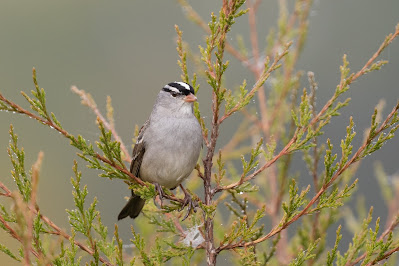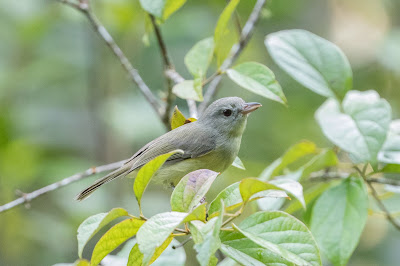Three years ago I was guiding on the west coast of the Yucatan Peninsula in Mexico. Among the 200+ species we enjoyed on that tour was this distinctive silhouette of a Turquoise-browed Motmot:
Both male and female motmots habitually wag their racket-shaped tails back and forth like a pendulum. Do you know why?27 November 2020
Why wag?
21 November 2020
Quiet November
Truth be told, I haven't done much in the way of birding lately. I did venture up to Lovers Leap, which is a bluff overlooking Hannibal and the Mississippi River, to check things out. Among a few expected things was this nice NORTHERN HARRIER that flew over:
16 November 2020
On this day...
This COMMON REDPOLL, drenched in late-day winter light, posed for me at Whitefish Point in northern Michigan on this day, a whopping 13 years ago:
13 November 2020
Year ago
A year ago this month, I was exploring forests in Jamaica. I have to say, I do miss spending time with these little sprites, the Jamaican Tody:
30 October 2020
Another sparrow
This handsome guy is a WHITE-CROWNED SPARROW that was along a field edge near here earlier this month:
We have a short window to enjoy these locally though, I usually only see them during spring and fall migration. With November almost upon us, winter is on the move as well.
25 October 2020
Resurrection?
As you can see, I haven't actually posted on this blog since... February. 😶
Maybe posting something, anything, might be the catalyst I need to revive this? It's worth a shot.
Anyway, here's a LECONTE'S SPARROW from the other day. This is a little and secretive denizen of thick grass and marshes. It's also one of my favorite fall migrants here in the Midwest.
21 February 2020
The Edges of Costa Rica -- Deep South
The "Birding the Edges" tours that we run there take birders to less-traveled parts of the country. Of course, as always, you can find a lot more info about the tour here.
After arriving and looking out from the room balcony, it was hard not to contrast where I just came from with what I was seeing:
One of the main targets in central Costa Rica is the now-endemic CABANIS'S GROUND-SPARROW which I found nicely near the hotel:
The Edges Part 1 tour was quite good for hummingbirds and we tallied about 30 different species. Included was this WHITE-THROATED MOUNTAIN-GEM:
As is typical with much of the Neotropics, one can expect a fun variety of tanagers and included in that list was the aptly-named SILVER-THROATED TANAGER:
A lot of birders really like the trogons. This is a COLLARED TROGON:
Anyway, Edges Part I was a success and I think we all enjoyed our time exploring the southern reaches of the country. I'll leave you with this view to help melt your frozen winter blues:
16 February 2020
Jamaica
Over the course of 2-3 weeks, I got to know the birds pretty quickly, tallied ~120 species, and got to meet some really nice folks. In fact, I'll be headed back there in 2021.
Anyway, here are some photos.
BLUE MOUNTAIN VIREO, found only in Jamaica:
"Golden" subspecies of YELLOW WARBLER:
JAMAICAN BLACKBIRD, endemic to Jamaica:
JAMAICAN SPINDALIS, found only in Jamaica:
RUFOUS-TAILED FLYCATCHER, a Jamaican endemic:
JAMAICAN OWL, a tough-to-see Jamaican endemic:
WHITE-EYED THRUSH, one of my favorite Jamaican endemics:
JAMAICAN TODY, another endemic and a colorful little ball of energy:
ORANGEQUIT, found only in Jamaica:
Roadside birding:
Our lodge has this old Spanish-built stone tower on the grounds; it was really neat to explore!
13 February 2020
Cajun Country
Although this is a very short tour, only 3 days of birding, we amassed 150+ species of birds. This is due to the very different habitats we visit: flooded rice fields, upland pine forests, and coastal marshes and shorelines.
In the pine forests we tracked down a couple of key species like RED-COCKADED WOODPECKERS. Here are three in one tree:
Another target in the pine forests was this BACHMAN'S SPARROW:
One of the major surprises from this tour was when a NORTHERN WHEATEAR showed up at a nearby airport. We swung through to check out this major rarity:
I was thinking, this tour might be the only one I do where the default chickadee is the CAROLINA CHICKADEE:
But of course, the main draw on this tour is to see YELLOW RAILS. We get to ride around on the rice combine and watch as these hard-to-see rails flush from in front and fly to safety. On this tour, I ended up seeing 50! It's a wild ride!
07 February 2020
Australia in October
Because it was a long tour (I was in Australia for 3-4 weeks), I'll include a few more photos here just for kicks. For starters, here's the massive Powerful Owl, the largest owl species in Australia:
Some of the pigeons are pretty crazy down there. The Crested Pigeon is surely one of the more distinct ones:
It was on this tour that I saw my 2nd ever species of penguin. Little Penguins can be found after dark in Melbourne:
Yellow-tailed Black-Cockatoos are always stunners:
Australia has a ton of honeyeaters (the most diverse family of songbirds there). One of them, the Spiny-cheeked Honeyeater, is actually a pretty sharp-looking bird:
And of course you have Emus walking around some places. Nothing to see here, just a 80-90 lb flightless bird:
The Pink Cockatoo was definitely a highlight; what a stunning bird:
Personally, I really enjoyed finally seeing the Rock Parrot, a coastal specialty of southwestern Australia:
What IS this creature??? An owl? Nightjar?
All for now.

















































